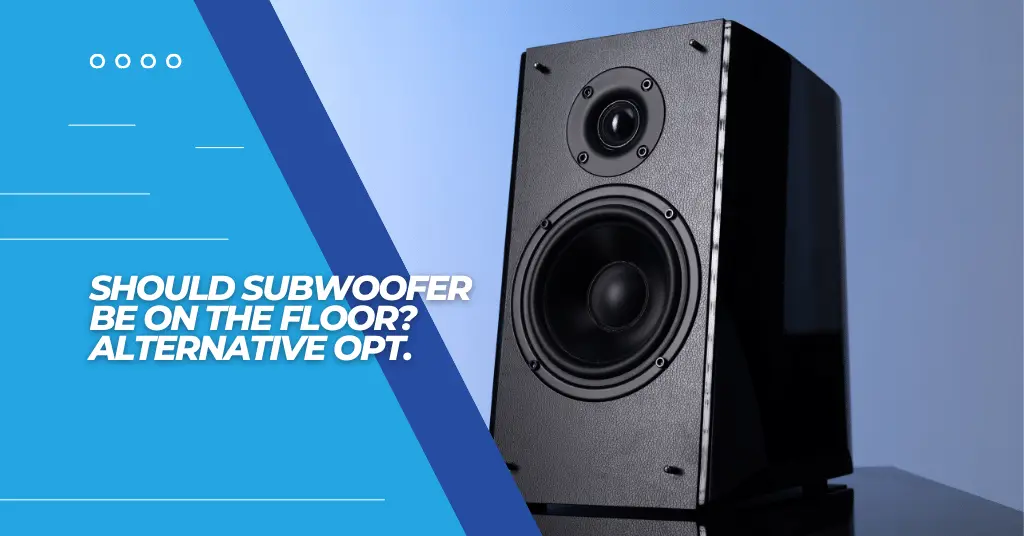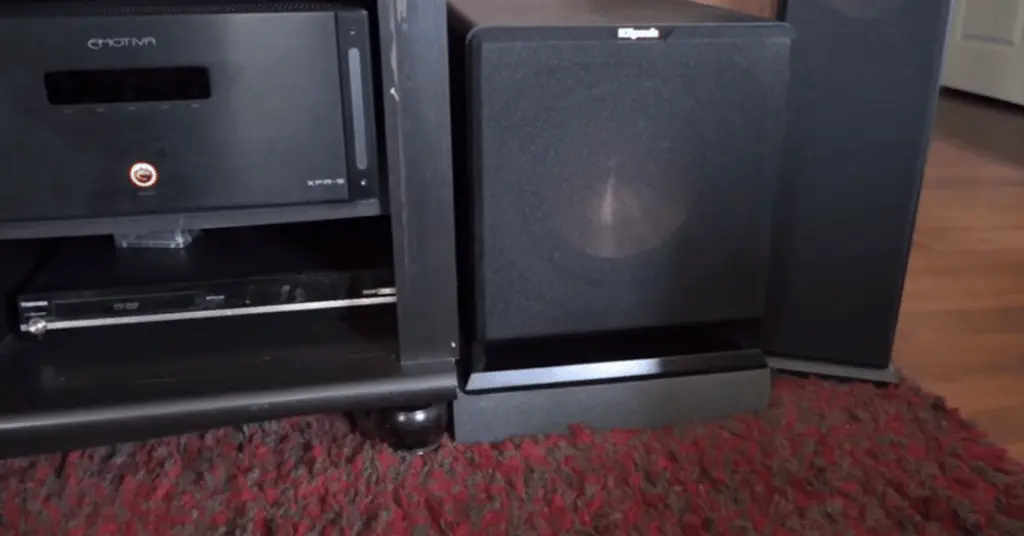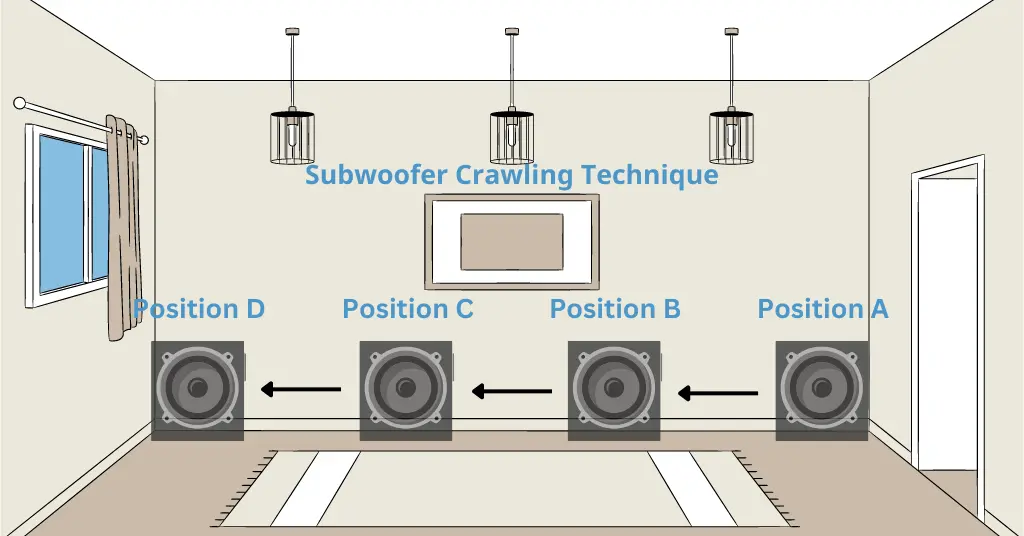Should a Subwoofer Be on the Floor?

A lot of times, I have been asked if you could place the subwoofer on the floor. However, there are significant limitations to placing the sub directly on the floor, but it might come up with decreased sound quality.
In a way, putting the sub on the ground level might increase bass frequencies due to floor reinforcements. However, the direct floor subwoofer connection may cause sound reflection, leading to “boomy” bass and potential vibration issues. In some cases, I have found the floor (using isolation pads or platforms between the setup) to be an excellent choice as it offered deep bass.
3 Reasons Not to Put Subwoofer on the Floor:
Here are the top 3 reasons that may convince you if the subwoofer should be placed on the floor or not:
1. Sound Reflection and Boomy Bass:
One of the most significant drawbacks I have found is that directly placing the subwoofer on the floor, especially hard surfaces like tiles or hardwood, can lead to sound reflection.
Mainly, this reflection occurs when the sound waves generated by the subwoofer bounce off the hard surface, creating secondary waves that can interact with the original sound waves in complex ways.
When these reflected waves coincide with the initial waves at specific frequencies (it can also be mid and high frequencies from surround speakers), a phenomenon known as “standing waves” occurs.
However, standing waves may significantly impact the sound output in the room. They can create areas where the bass sound is amplified, leading to a ‘boomy’ sound effect, and other areas where the bass sound may be nearly inaudible.
As a result, this uneven bass distribution can create a ‘muddy’ sound effect, as the reflected waves interfere with the clear perception of the original sound.
2. Potential for Rattle and Vibration:
As a result of sound wave reflection and strong bass, you may also face rattling and vibrating noises. This is because home theater subwoofers generate low-frequency sound waves, which are particularly prone to causing vibrations.
These vibrations can transfer to the floor and cause it to resonate, particularly if the user’s floor is made of a hard surface like wood or concrete.
Shockingly, the resonating floor can also vibrate other objects in the room, causing a noticeable rattle. Additionally, these vibrations can also cause the structure of the room itself – walls, ceiling, windows – to vibrate. This can be distracting for listeners and distort the sound quality, causing it to feel “muddled” or “muddy.”
3. Inefficient Bass Distribution:
Another potential drawback you may also face is the uneven bass distribution. The resonant frequencies occur in your entertainment system when the room’s dimensions coincide with the wavelengths of the sound produced by the subwoofer.
This often results in areas of the room having overly loud bass (bass hotspots) and others having little to no bass. However, you might find some help after elevated subwoofer (which I will discuss later below).
Tips to Prevent Drawbacks if You Really Want to Put Subwoofer on the Floor:
If you really want to put the subwoofer on the floor, even after reading the potential drawbacks, you can follow the below tips that will help you to enjoy the low frequencies:
1. Isolation Pads or Platforms:

Isolation pads or platforms (speaker stands as an example) will work like a charm when placing a subwoofer on the floor.
They simply serve to ‘decouple’ the subwoofer from the floor, minimizing the contact between the two surfaces. This decoupling action significantly reduces the vibrations transferred to the room structure.
By lessening these vibrations, the isolation platforms or pads can substantially reduce the occurrence of rattling and other unwanted noises that can emanate when a subwoofer is in use.
As a result, you will get a cleaner, more precise, maximum bass output, improving the overall sound output of your speaker system.
2. Position Away From Walls:

While putting the subwoofer on platforms or pads, I will also suggest you keep it away from the walls. The reason behind this is simply related to a concept known as standing waves (that I have discussed above), which are essentially the reflections of sound waves off walls and other surfaces.
Placing the subwoofer slightly away from the wall allows the sound waves it produces to disperse more evenly throughout the room.
This minimizes the likelihood of standing waves forming and thus improves the overall audio quality. Additionally, this subwoofer placement reduces the risk of the subwoofer’s vibrations being transferred to the wall, which can cause additional distortions.
However, a good rule of thumb is to start with the subwoofer about a foot away from the wall and then adjust as necessary to achieve the desired sound quality.
3. Use a Rug or Carpet:
If you don’t want to use an isolation pad and have hard surfaces such as hardwood or tile, you can also use a rug or carpet between the floor and the subwoofer.
The logic is simple when sound waves from the subwoofer bounce off the hard surface, creating an echo that can distort the low frequencies output, making it sound muddled or overly resonant.
Placing a thick rug or carpet underneath the subwoofer solves this issue. The absorbent material of the rug or carpet acts as a dampener, absorbing some of these reflected sound waves.
This absorption prevents the waves from interfering with the original sound emanating from the subwoofer, enhancing the clarity of the bass.
In addition, a rug or carpet can provide a more stable foundation for the subwoofer, reducing vibrations and further improving the sound quality.
Alternative Options if You Don’t Want to Place Subwoofer on the Floor:
Well, If you have decided not to place the subwoofer directly on the floor, you can use these options that might surprise you for sure:
1. Corner Placement:

Subwoofer corner placement can be a viable alternative to floor placement. This position leverages the concept of boundary reinforcement, amplifying the subwoofer’s output by using the room’s corners.
As a result, the bass sound produced is louder and potentially more immersive, making corners an efficient use of space and a way to diffuse the sound’s source.
However, you may have some drawbacks. For example, an enhanced bass might sound appealing initially, but it can lead to an overpowering “boomy” bass that may not be pleasant to all listeners.
2. Wall or Ceiling Mount:
A wall or ceiling can be an excellent choice for the subwoofer, presenting unique acoustic advantages and space-saving benefits.
Depending on your room’s layout, this placement can distribute sound more uniformly across the space.
Moreover, if you have a pet in your home, this placement will allow you to keep home theater setup wires away to prevent them from chewing. However, the installation process can be complex, often requiring specific brackets or even custom mounts.
3. Perform a Subwoofer Crawl Technique:

If you are still unable to decide on the convenient option, then I’ll suggest you perform the crawling method. The subwoofer crawl technique is a practical method to find the optimal location for a subwoofer without necessarily placing it on the floor. You might think this process to be a bit odd, but it’s effective.
However, it involves establishing the subwoofer in your normal listening position, say, the couch or a favorite chair. Then, play some bass-heavy music at a reasonable volume.
Now comes the ‘crawl’ part. You literally crawl around your room, listening carefully to the bass sound. The best location for your subwoofer is where the bass sounds most balanced, not too boomy or too weak.
This sweet spot could be on a shelf, in a cupboard, or on any elevated surface that doesn’t hinder the subwoofer’s output.
General FAQs
Can You Put the Subwoofer on Your Ear Level Like a Bookshelf?
Yes, a subwoofer can be placed at ear level, such as on a bookshelf, though it’s not a common practice. Subwoofers emit low-frequency sounds that are less localized and spread out in all directions. While this might reduce some room resonances, it could compromise the bass depth and cause shelf items to vibrate. If chosen, ensure the subwoofer is secure and the shelf sturdy to prevent it from falling.
Should I Put My Subwoofer on the Floor or Table?
Placing your subwoofer on the floor can amplify bass due to ground reinforcement. However, it may result in a “boomy” sound from reflections. Putting it on a table could reduce floor reflection issues, offering clearer bass, but vibrations might distort the sound. Hence, the optimal choice depends on room acoustics, subwoofer design, and personal preference.
Is It Okay to Put a Down-Firing Subwoofer on the Carpet?
Yes, it is typically okay to put a down-firing subwoofer on the carpet. However, it is recommended to elevate it slightly off the ground for optimal performance. This allows for better driver movement, reducing the chances of muffled sound. Experimenting with subwoofer placement can help achieve the most satisfying bass response.
Does the Type of Flooring (Carpet, Hardwood, Tile) Affect Subwoofer Performance?
Yes, the type of flooring can significantly impact subwoofer performance. Hard surfaces like tile and hardwood reflect sound waves, possibly causing echo or distortion. Carpet, on the other hand, absorbs some of these waves, providing a dampening effect. Positioning and room acoustics also play substantial roles in optimizing subwoofer performance.
How Close Should a Subwoofer Be to the Wall?
A subwoofer’s placement can significantly impact its performance. Ideally, it should be 9-12 inches away from the wall. This position minimizes potential sound distortion from wall reflections, enhancing the overall audio quality. However, the room’s acoustics, subwoofer type, and personal preference may necessitate adjustments.

